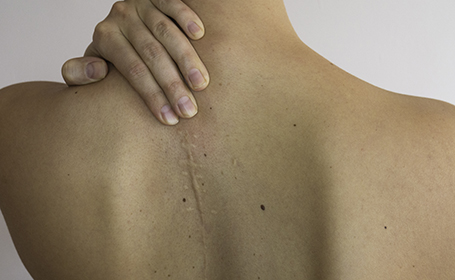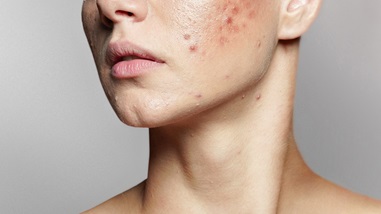
How to treat scars
Scars can often not only leave a physical mark, but they can also affect people mentally as well
Even though you can't remove scars, there are ways to help treat them and make them less visible. Find out more about what causes scarring and what you can do to treat yours.
What causes scarring?
A scar is a mark that is left on the skin after a wound or an injury to the skin has healed.
Scars are permanent; however, they usually fade over a period of time. Scars can be caused from a variety of things including:
- Burns
- Injuries
- Bites
- Body piercings
- Tattoos
- Surgery
- Complications of conditions such, as acne or chickenpox
What are the different types of scars?
The type of scar formed depends on a number of different things such as how the scar was caused, the patient's skin type and their genetics.
- Flat, pale scars - These scars are extremely common. They'll often start off red or dark and raised, however, will become paler and flatter over time, usually a period over two years.
- Hypertrophic scars - These are raised, red scars that form along a wound. These scars can stay like this for years but do ultimately tend to flatten and become paler to some degree.
- Keloid scars - These form due to excess scar tissue produced at the site of the wound and the scar grows beyond the initial wound. Most keloid scars continue to grow even after they have healed. Keloid scars are more common in certain body parts such as over the breast bone, shoulder and earlobe. These scars can be itchy and sometimes painful.
- Pitted scars - These are sunken-looking scars and are often caused by skin conditions such as acne
- Contracture scars - Contracture scars are mostly caused by burns or scalds. The skin appears tight, which can restrict movement particularly when the scars cross joints
- Stretched scars – these scars tend to be flat and pale but are wide. They tend to occur in patients with thin skin who may also have stretch marks, or when wounds are closed very tightly.
There are a range of treatments available to treat all different types of scars. Options will depend on the type and age of the scar.
What are the options available to treat scars?
There are a range of treatments available to treat all different types of scars. Options will depend on the type and age of the scar and they can't completely remove the scar.
However, treatment can improve the appearance. If you feel like a more permanent option is better for you, there are a range of clinical treatments for scars that are available too.
Pressure garments
Pressure garments are often used for scars caused by burns, or after skin grafts. They are used to flatten and soften the scar and are worn 24 hours a day for between 6 to 12 months. Pressure garments can also be useful in the treatment of hypertrophic and keloid scars. Clip on earring style pressure devices are useful for treating keloids scars on earlobes.
Silicone gel treatment
Silicone treatments for scars in the forms of gels or sheets that are placed on top of scars have been shown to improve scarring when used 24 hours a day for at least two months.

Make-up
Professional camouflage make-up helps to cover up scars and is commonly used for facial scars. You can access camouflage make-up designed specifically for scars from a pharmacy, but we would advise speaking to your GP first for advice.
Camouflage colour testing is also an option with this treatment. By colour testing, you can purchase make-up that matches your skin type really well.
You will need to go to a professional to get this procedure done and it can take over an hour to perform.
Laser therapy
Laser therapy can reduce the redness in a scar by targeting the blood vessels in the excess scar tissue. This treatment is often used for pitted scars to attempt to make the scar flatter. If you're thinking about having laser therapy, it's essential that you go to a medical practitioner with experience in treating scars.
Dermal fillers
This treatment involves injections to, essentially, fill pitted scars. Using dermal fillers as a treatment for scars can be expensive and you will need to go back for repeat injections in order to see results, which are usually temporary.
Surgery
There are a variety of plastic surgery operations that can be used to improve scars. Different operations are used for different types of scarring and a consultation with a plastic surgeon is therefore necessary to choose the most appropriate treatment on an individual basis. These procedures all generally improve the appearance of the scars, remove tightness and improve the robustness of the tissue.
Some poor scars occur because of problems with wound healing such as wound infection, excessive bleeding following surgery, the wound not being stitched up at the time of injury, or the wound opening up as a result of stitches snapping or coming undone. These scars can often be improved by scar revision where the poor scar is removed and the wound closed meticulously.
Scar contractures can occur after burns, scalds, or when scars cross joints. Scar contractures can be improved by releasing the scar surgically and then lengthening it by either moving healthy adjacent flaps of skin inwards or by using skin grafts.
Sometimes scars are conspicuous because of the direction in which they run and in some cases it is possible to reorientate the scar by moving adjacent skin flaps around so that the scar is less obvious. Other scars can be very visible because of differences in the thickness of the tissue on either side of the wound. This happens quite frequently following caesarean sections and can be improved with scar revision surgery.
It's important to explain to your consultant the history of how you got your scar and any relevant information that you may think will help. As well as this, keep in mind that scarring affects everyone differently. Your consultant will be able to offer you the best option specifically for you and your skin.
Many different skin creams are available on the market but there is very little (if any) scientific evidence that any of these creams have any significant effect on reducing scarring.

Ask the expert
Consultant plastic surgeon Andrew Morritt from Thornbury Hospital answers some of the most frequently asked questions about scars.
Do skin creams help?
Many different skin creams are available on the market but there is very little (if any) scientific evidence that any of these creams have any significant effect on reducing scarring. Bio-oil is popular with many patients and may improve the appearance of a scar by keeping the skin hydrated however I am unaware of any scientific evidence that it reduces scarring. The only products that do seem to reduce scarring are silicone gels such, as Kelo-coat or Dermatix.
How can you prevent or minimise scarring?
A large part of scarring is related to a persons skin type and genetics and in that sense cannot be modified significantly. Other factors such as, scar orientation, placement, meticulous surgical technique and reducing tension on the scar can be modified to minimise scarring. Wounds get stronger as time passes and many surgeons therefore recommend using tape (e.g. micropore tape) to support young scars as they mature in the early phase of wound healing. There is some scientific evidence that silicone gels or sheets can help reduce scarring.
What is the most difficult scar to treat?
A number of scars are difficult to treat for differing reasons. Some keloid scarring can be extensive and be impossible to remove even with multiple different treatments. Other scars such as stretched scars that may occur in patients with multiple stretch marks are also very difficult to improve as the skin itself is weaker than normal skin and scars are prone to stretching again after scar revision surgery.
At Circle Health Group, our plastic surgeons are highly qualified in a range of cosmetic treatments for correction and reconstruction of scars. They will offer you honest, helpful advice and will be able to tell you which route is best for you. We also offer other cosmetic procedures including pinnaplasty (ear correction), breast reconstruction and septorhinoplasty.
Tags
How do I book an appointment?
If you're concerned about symptoms you're experiencing or require further information on this subject, talk to a GP or see an expert consultant at your local Circle Hospital.